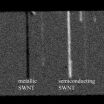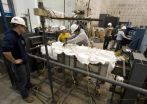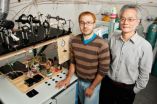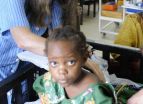(Press-News.org) WEST LAFAYETTE, Ind. - Researchers have demonstrated a new imaging tool for rapidly screening structures called single-wall carbon nanotubes, possibly hastening their use in creating a new class of computers and electronics that are faster and consume less power than today's.
The semiconducting nanostructures might be used to revolutionize electronics by replacing conventional silicon components and circuits. However, one obstacle in their application is that metallic versions form unavoidably during the manufacturing process, contaminating the semiconducting nanotubes.
Now researchers have discovered that an advanced imaging technology could solve this problem, said Ji-Xin Cheng, an associate professor of biomedical engineering and chemistry at Purdue University.
"The imaging system uses a pulsing laser to deposit energy into the nanotubes, pumping the nanotubes from a ground state to an excited state," he said. "Then, another laser called a probe senses the excited nanotubes and reveals the contrast between metallic and semiconductor tubes."
The technique, called transient absorption, measures the "metallicity" of the tubes. The detection method might be combined with another laser to zap the unwanted metallic nanotubes as they roll off of the manufacturing line, leaving only the semiconducting tubes.
Findings are detailed in a research paper appearing online this week in the journal Physical Review Letters.
Single-wall nanotubes are formed by rolling up a one-atom-thick layer of graphite called graphene, which could eventually rival silicon as a basis for computer chips. Researchers in Cheng's group, working with nanomaterials for biomedical studies, were puzzled when they noticed the metallic nanoparticles and semiconducting nanowires transmitted and absorbed light differently after being exposed to the pulsing laser.
Then researcher Chen Yang, a Purdue assistant professor of physical chemistry, suggested the method might be used to screen the nanotubes for nanoelectronics.
"When you make nanocircuits, you only want the semiconducting ones, so it's very important to have a method to identify the metallic nanotubes," Yang said.
The paper was written by Purdue physics doctoral student Yookyung Jung; biomedical engineering research scientist Mikhail N. Slipchenko; Chang-Hua Liu, an electrical engineering graduate student at the University of Michigan; Alexander E. Ribbe, manager of the Nanotechnology Group in Purdue's Department of Chemistry; Zhaohui Zhong, an assistant professor of electrical engineering and computer science at Michigan; and Yang and Cheng. The Michigan researchers produced the nanotubes.
Semiconductors such as silicon conduct electricity under some conditions but not others, making them ideal for controlling electrical current in devices such as transistors and diodes.
The nanotubes have a diameter of about 1 nanometer, or roughly the length of 10 hydrogen atoms strung together, making them far too small to be seen with a conventional light microscope.
"They can be seen with an atomic force microscope, but this only tells you the morphology and surface features, not the metallic state of the nanotube," Cheng said.
The transient absorption imaging technique represents the only rapid method for telling the difference between the two types of nanotubes. The technique is "label free," meaning it does not require that the nanotubes be marked with dyes, making it potentially practical for manufacturing, he said.
The researchers performed the technique with nanotubes placed on a glass surface. Future work will focus on performing the imaging when nanotubes are on a silicon surface to determine how well it would work in industrial applications.
"We have begun this work on a silicon substrate, and preliminary results are very good," Cheng said.
Future research also may study how electrons travel inside individual nanotubes.
INFORMATION:
The research is funded by the National Science Foundation.
Related websites:
Ji-Xin Cheng:
https://engineering.purdue.edu/BME/Research/Labs/Cheng
Weldon School of Biomedical Engineering:
http://www.purdue.edu/bme
Department of Chemistry:
http://www.chem.purdue.edu/
Chen Yang:
http://www.chem.purdue.edu/people/faculty/faculty.asp?itemID=81
IMAGE CAPTION:
Metallic and semiconducting single-wall carbon nanotubes are distinguished using a new imaging tool for rapidly screening the structures. The technology may hasten the use of nanotubes in creating a new class of computers and electronics that are faster and consume less power than those in use today. (Weldon School of Biomedical Engineering, Purdue University)
A publication-quality photo is available at http://news.uns.purdue.edu/images/2010/cheng-nanotubes.jpg
Abstract in this release is available at: http://www.purdue.edu/newsroom/research/2010/101116ChengNanotubes.html
Imaging tool may aid nanoelectronics by screening tiny tubes
2010-11-17
ELSE PRESS RELEASES FROM THIS DATE:
Engineers test effects of fire on steel structures
2010-11-17
WEST LAFAYETTE, Ind. - Researchers at Purdue University are studying the effects of fire on steel structures, such as buildings and bridges, using a one-of-a-kind heating system and a specialized laboratory for testing large beams and other components.
Building fires may reach temperatures of 1,000 degrees Celsius, or more than 1,800 degrees Fahrenheit, said Amit Varma, a Purdue associate professor of civil engineering who is leading the work.g1
"At that temperature, exposed steel would take about 25 minutes to lose about 60 percent of its strength and stiffness," he ...
Organ network uses Carnegie Mellon algorithm to match live kidney donors with recipients
2010-11-17
PITTSBURGH—A computer algorithm developed at Carnegie Mellon University matched living kidney donors with medically compatible transplant candidates late last month as the national Organ Procurement and Transplantation Network (OPTN), operated by the United Network for Organ Sharing (UNOS), began a national pilot program to increase the number of kidney paired-donation (KPD) transplants.
The initial run of the computer matching process included just 43 kidney transplant candidates and 45 potential living donors, but a national KPD pool eventually could include as many ...
International discussions on FRAX smooth the way for implementation in clinical practice
2010-11-17
Three days of critical international discussion and debate, led by a panel of experts from the International Society of Clinical Densitometry (ISCD) and the International Osteoporosis Foundation (IOF), have served to clarify a number of important questions pertaining to the interpretation and use of FRAX® in clinical practice.
The WHO Fracture Risk Assessment Tool (FRAX®), with models for some 26 countries, is an important new online tool that is being used by a steadily increasing number of physicians around the world. FRAX® is country-specific and calculates a patient's ...
Heart surgeries can trigger strokes, seizures and other neurological complications
2010-11-17
Strokes, seizures and other neurological complications related to heart surgery account for "considerable morbidity and mortality," Loyola University Health System neurologists report in the November issue of the journal Hospital Practice.
Other complications include delirium, central nervous system infections, pituitary gland problems, spinal cord or peripheral nerve injuries, residual effects of anesthesia and medication toxicity.
Complications can involve any part of the central and peripheral nervous systems. "Neurologic complications are always a risk with cardiac ...
Depression linked to HIV risk among South African young people, study shows
2010-11-17
University of Alberta research has discovered a strong link between depression and risky sexual behaviours such as improper condom use, transactional sex and relationship violence among young people in South Africa.
The research shows that depression is common among young South Africans, and could be making a significant contribution towards the HIV epidemic.
As well, the researchers believe that depression could be contributing to risky sexual behaviours around the world, and that preventing or treating it may reduce the global burden of sexually transmitted diseases, ...
Listening for ocean spills and their ecological effects
2010-11-17
November 16, 2010 -- Scientists who study acoustics (the "science of sound") have over the years developed a variety of techniques to probe the hidden depths of oceans. This week, many of these acoustic researchers will come together to discuss how these technologies were used to monitor April's Deepwater Horizon oil spill, to present new data on the gusher's ecological impacts, and to highlight new techniques under development that could improve our ability to detect oil in ocean water.
This special session will take place on November 17, 2010 at the 2nd Pan-American/Iberian ...
Research links damaged organs to change in biochemical wave patterns
2010-11-17
By examining the distinct wave patterns formed from complex biochemical reactions within the human body, diseased organs may be more effectively identified, says Zhengdong Cheng, associate professor in the Artie McFerrin Department of Chemical Engineering at Texas A&M University, who has developed a model that simulates how these wave patterns are generated.
His findings, which appear in the October issue of the journal "Physical Review E," detail Cheng's work with a system designed to model cells in a biochemical environment, similar to what occurs inside the human body.
His ...
Study rewrites the evolutionary history of C4 grasses
2010-11-17
CHAMPAIGN, Ill. — According to a popular hypothesis, grasses such as maize, sugar cane, millet and sorghum got their evolutionary start as a result of a steep drop in atmospheric carbon dioxide levels during the Oligocene epoch, more than 23 million years ago. A new study overturns that hypothesis, presenting the first geological evidence that the ancestors of these and other C4 grasses emerged millions of years earlier than previously established.
The findings are published in the journal Geology.
C4 plants are more efficient than C3 plants at taking up atmospheric ...
Program for young students increases interest in college attendance and medical careers
2010-11-17
Two new studies have shown that a unique program in East Harlem that helps middle school students learn practical health skills and gain a better understanding of medical conditions, such as diabetes and hypertension, resulted in increased interest in college attendance and medical careers among the students who attended the program. The results were presented at the American Public Health Association (APHA) Annual Meeting this month in Denver.
The MedStart Summer Enrichment Program was created in the summer of 2009 by Edward Chu and Melissa Schneiderman, two third-year ...
Researchers link cerebral malaria to epilepsy, behavior disorders
2010-11-17
EAST LANSING, Mich. — Almost a third of cerebral malaria survivors developed epilepsy or other behavioral disorders in the most comprehensive study to date of the disease in African children, solidifying the link between malaria and neuropsychiatric disorders that affect hundreds of thousands of children.
The research – led by Gretchen Birbeck, an associate professor of neurology and ophthalmology in Michigan State University's College of Osteopathic Medicine – appears in the current edition of The Lancet Neurology.
Cerebral malaria is a severe form of malaria affecting ...



